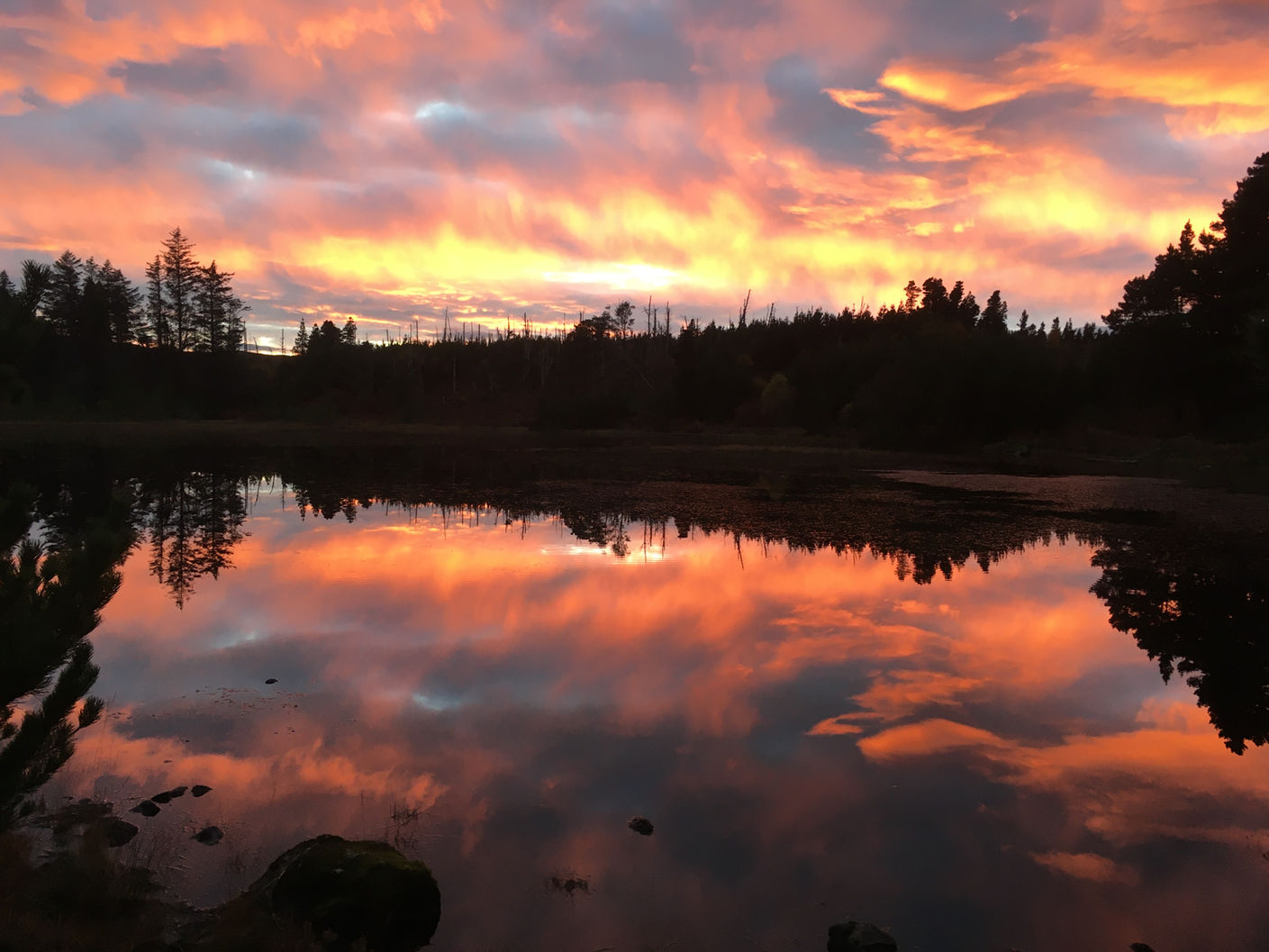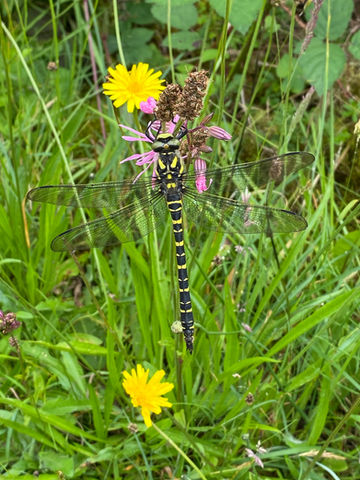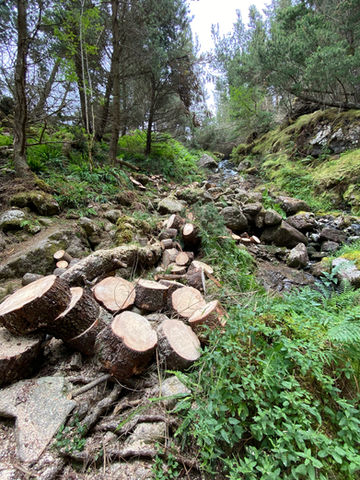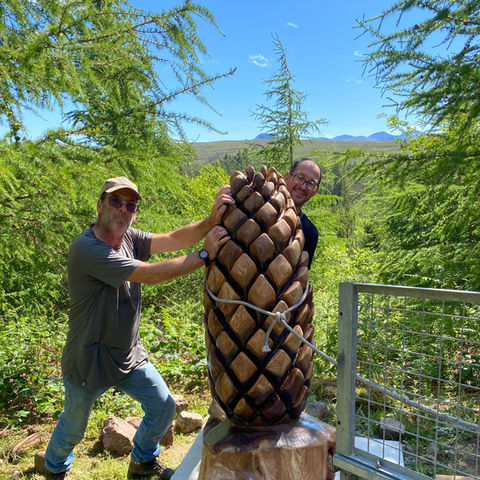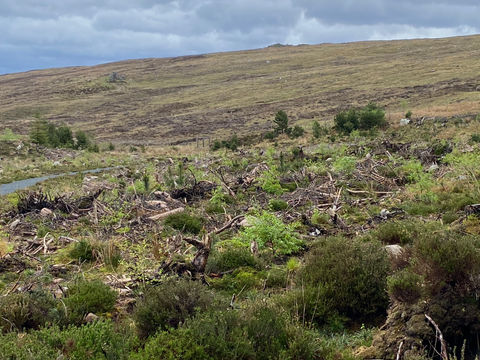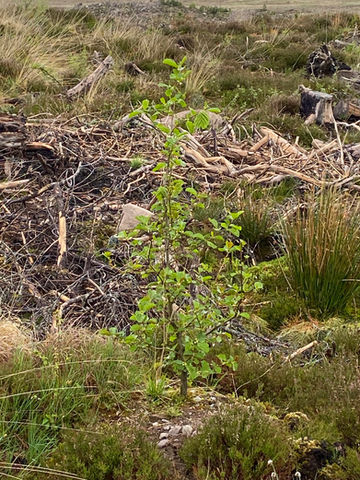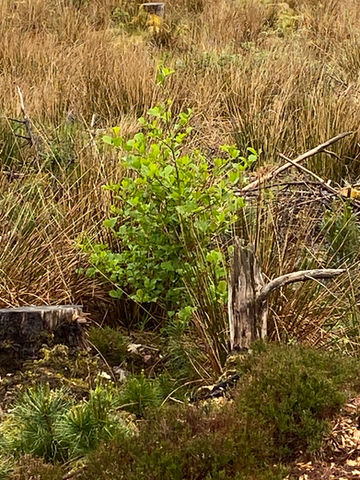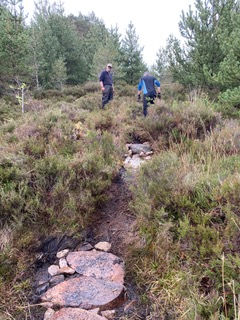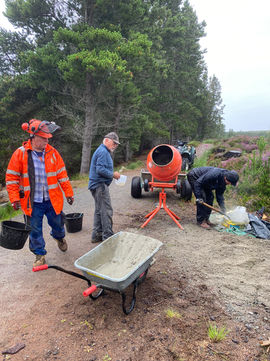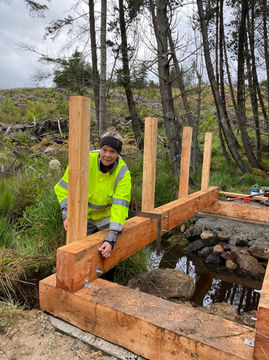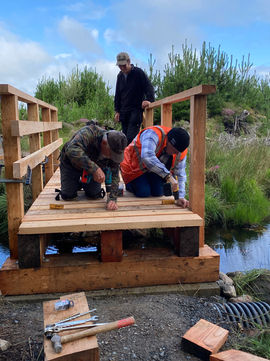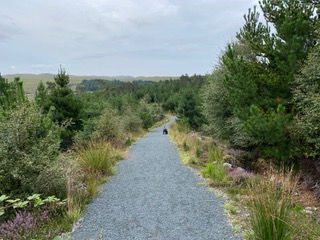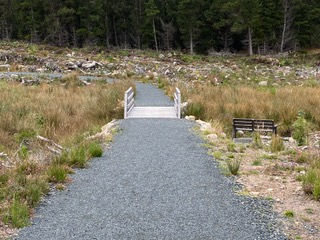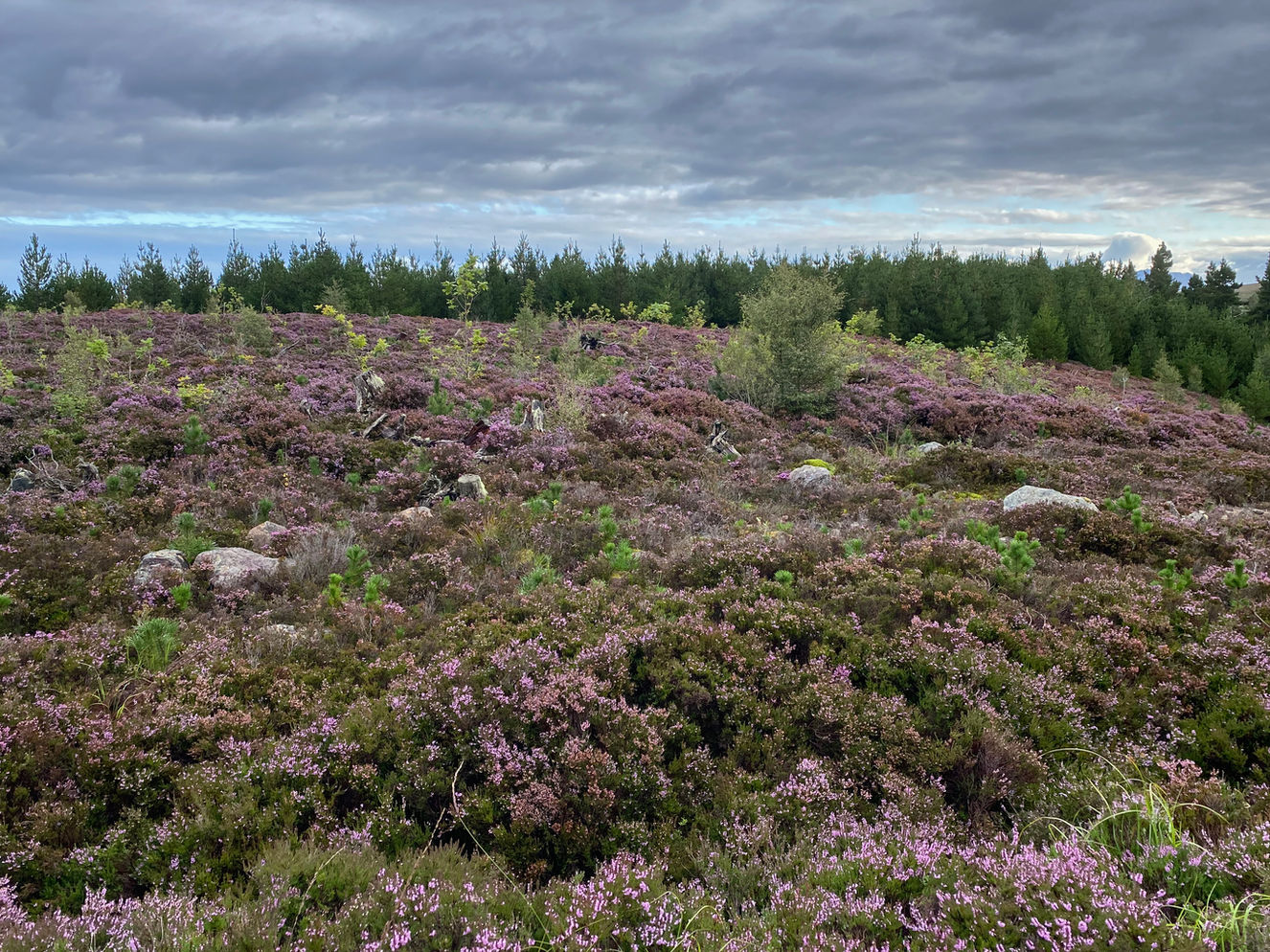Welcome to
Laide & Aultbea Community Wood

Located in the West Highlands, Laide & Aultbea Community Woodland (LACW), including two inland lochs, extends to 86.6 hectares (214 acres). It was originally owned and planted with mostly conifers by the Forestry Commission between 1963-67. Little management was carried out and the woodland was sold in 1993 and then changed hands several more times before being purchased by the community in 2003 when LACW was established.
Since 2003, trails have been created, bridges built, a bird hide constructed and over 62,000 (mostly) new broadleaf trees planted. A new 1.4km trail was completed in 2020 and a fully accessible picnic area developed in 2021.
The woodland is run by Trustees/Directors drawn from the local community and has an enthusiastic volunteer team and active membership, all of whom help to achieve our key charitable objectives:
To manage access to LACW, provide opportunities for recreation and conserve, regenerate and preserve the woodland
To encourage community involvement in the management of the woodland
Everyone is welcome at LACW and we hope you enjoy your visit
Emails are working again
We are very sorry if you have tried to e-mail us over the last few months, and had no reply.
It was found that emails were not getting through the system and nobody was able to see them.
However that has now been sorted, and we can see emails again.
Please feel free to contact us again.
Follow the links in the contact us section
info@laidewood.org.uk or volunteer@laidewood.org.uk
We are also in the process of getting the website updated (please bear with us whilst we get or heads round the system)
Latest News
White Tailed Eagles, Otters & a blanket of snow visits Laide Wood
January 2024
In the middle of January we received an icy blast from the Arctic which covered Wester Ross in possibly the most snow the area has seen in around 15 years. Whilst it caused some issues for people getting around it certainly didn't hinder the local wildlife. During an early morning walk we found evidence of where an otter had slid through the snow towards one of the burns, deer prints were found along the trails & in between heavy snow showers two White Tailed Eagles took the opportunity to hunt over the wood.

Summers Bounty
June 2023
The wood is abundant with life & colour at the moment. The wildflowers are in full bloom, the young trees which were planted along the Heather Trail a few years ago are strong & healthy and the birds, insects, mammals & many other species are taking full advantage of all that the wood has to offer.
When walking along the Heather Trail visitors may notice many dead saplings on the ground, these are invasive self seeded Lodge Pole Pine & Sitka Spruce which have been removed by the volunteers. This is a necessary & ongoing process to allow the newly planted deciduous trees & Scots Pine space & light to flourish.
When looking through the photos below you may glimpse a Long Tailed Tit chick & an adult Grebe with 3 chicks. It's fantastic to see so many people recording their wildlife sightings on the board in the wildlife hide. It's so encouraging to know that the wood supports such a diverse range of flora & fauna.
In recent months you may have noticed that the old wooden benches have been replaced with recycled plastic benches which have durability, will be low maintenance & far easier for the volunteers to look after. We would like to thank everyone who donated towards the new benches.

One year on from Storm Eunice
March 2023
It is just over a year since Storm Eunice left it's presence on the wood. The wood had to close to visitors for a spell due to the damage. Volunteers & Trustees worked tirelessly to clear up after the storm & reopen the trails that had been blocked by fallen trees & tree tops. There is still some evidence of the storm damage but it is really good to see the wood looking exceptional despite adversity.
Here are some before & after photo's.....

Laide Wood in glorious Summer bloom
July 2022
Whilst the sun has been a little shy of late the flora in the wood certainly hasn't, the woodland has exploded into colour in recent weeks.
It is a delight to see so much variety at this time of year which the insects are thoroughly enjoying with the dragonfly & damselfly population out in full flight!
The warm weather hasn't put off the volunteer working parties either who have repaired a section of the red trail making the surface of the path much easier for walking on, removed a fallen tree which was lying across the cascade & blocking the view of the top section. These are just a few of the many jobs which have been carried out recently.
Come and see for yourself the beauty of the wood in Summer..........
Magnificent Cone to mark LACW's Success
June 2022
To celebrate our success in Scotland's Finest Woods Awards 2021, we commissioned a carved cone sculpture for all our visitors to enjoy.
On Wednesday 29th June 2022, LACW Chair, John Rippin, unveiled the sculpture to the applause of some of the wood's co-Trustees and regular volunteers.
The cone was sculpted in elm by Iain Chalmers, a well-known chainsaw sculptor from the Black Isle. We selected elm because it is a hardwood and therefore tough but with beautifully patterned burls.
We hope you agree that it's a really wonderful addition to this beautiful community wood.
New Trees Flourishing
May 2022
Since purchasing Laide Wood in 2003, Trustees were committed to replacing the 1960's plantation with a mixed species woodland so as to increase bio-diversity at LACW.
16,600 trees were planted at the end of 2019 / beginning of January 2020. These were mostly broadleaf including Alder, Willow, Aspen, Birch, Rowan, Oak, Hazel and Scots Pine.
The saplings are flourishing and we look forward to a more diverse woodland for future generations to enjoy.
You can see these new trees by walking the Heather Trail & part of the Two Lochs Trail.
New Link Trail!
May 2022
This short trail links the circular trail from the main car park with the "Heather Trail" from the north car park by the Old Smiddy B&B. Enjoy walking through the Scots Pine plantation but remember that some sections are soft underfoot and so may not be suitable for everyone.
Bridge Replacement Programme
2021 - Ongoing
With funding from the People’s Postcode Trust we have an ongoing bridge replacement programme for the five bridges on the main trails. We are using larch timber purchased from, and milled at, the National Trust for Scotland at Inverewe. Three bridges are complete and we will replace the remaining bridges by the end of 2023. Temporary closures of some paths may be necessary so we ask for your patience.
Your Woodland
There are three main trails in the woodland, two lochans, a cascade and a hide overlooking Loch Na Creige where you are very welcome to record your wildlife sightings. Seats are located throughout the woodland along the trails and there are picnic tables by Loch na Cathrach Duibhe and at the start of the Heather trail.


Please click .HERE. to download a PDF map of LACW
Easier Access Trail
The 1.4 km "Heather Trail" starts from the car park near to the Old Smiddy B&B. You enter the "View For All" picnic area via an easy access self-closing gate and the trail runs down to Loch Na Creige.
The well-maintained trail is top-dressed with firm, well compacted fine gravel, and crosses Sand Burn in two places via bridges. Generally, it is 2 metres wide and whilst the gradient for most part is relatively accessible, there are a few moderately steep sections (1:8). The "View For All" area is level. The short distance to reach the first seat has an initial 1:9 gradient so this may be a good way to decide if the path is suitable for your abilities.
People using wheelchairs and mobility scooters use the trail to reach Loch Na Creige where there is a seat overlooking the lochan.


About Us
Trustees and volunteers carry out:
-
Forestry management and maintenance
-
Financial management including fund-raising
-
Legal compliance
-
Administration
-
Health & safety
-
Promotion & PR
-
Delivery of projects
Volunteer Working Parties
Our working party days are held every Tuesday. Hands-on work includes maintenance of footpaths, fences and bridges as well as keeping paths weed-free, care of interpretation boards and anything needed to keep the wood safe for our visitors. It is a great way to learn about forestry management, get plenty of exercise and enjoy the fresh air in the company of others. We work throughout the year in rain, hail and shine.
New working party volunteers are not just thrown in at the deep end! Induction training is given and help is always on hand from other volunteers.
If you want to get involved or think you can contribute please click .HERE. to contact us and we will get back to you shortly.
Thank you to our recent grant funders








Awards
2019 awarded the Queen’s Award for Voluntary Service (the MBE for volunteer groups) in recognition of the work undertaken by volunteers.
2021 winners of Scotland’s Finest Wood Award for Small Community Woodlands. This prestigious award recognises the contribution our wood makes to the lives of local people and acknowledges the steps we are taking to ensure long term sustainability of the woodland.
Support LACW

Membership
As a member you help to cover on-going running costs and you are kept up to date with what’s happening.
Membership is great value and runs for 12 months from 1st September each year:
Full member over 18 years £5.00
Family membership - 2 adults over 18 years and children £10.00
Organisation/business £10.00
Concession £2.50
LACW is a Company Limited by Guarantee (without shareholders) and a Charity registered in Scotland. As a member you guarantee to contribute a maximum of £1.00 (one pound sterling) to any outstanding creditors should the company be wound down.
The easiest way to become a member is to complete the membership form and pay online by BACS.
Alternatively, you may wish to download the application form .HERE and then post your completed form with a cheque to the LACW Secretary (details on form).
LACW’s bank details are:
Bank: Bank of Scotland
Account name: Laide & Aultbea Community Woodland
Sort code: 80-06-87
Account no. 00439360
Please consider setting up a standing order to be paid on 1st September each year. Thank you.
Donate
LACW is run entirely by volunteers so there are no salary or administrative costs. Every penny donated is used for developing new initiatives at the woodland.
TO DONATE VIA PAYPAL CLICK BELOW

Gift Aid
If you’re a UK taxpayer, you can boost the value of your membership or donation through Gift Aid so LACW will be able to claim an extra 25p for every £1 you give. It will not cost you any extra.
If you are eligible, please tick the Gift Aid box on your donation form.

.jpeg)
Gallery

Downloads & Links
Downloads
LACW Articles & Memorandum of Association
LACW 2022 AGM Report from the Chair
Minutes of AGM 28th October 2022
LACW Report from the Chair 2022 - 2023
Fungi Foray Photo Collection 2023
Links
Community Woodlands Association
Scotland’s Finest Wood Awards
NTS Inverewe Gardens
Russian Arctic Convoy Museum
Beinn Eighe National Nature Reserve
Gairloch Museum
Contact Us

LACW is a charity registered in Scotland No. SC034434
LACW is a company registered in Scotland No. SC 249676 and is a Company Limited by Guarantee without share capital






